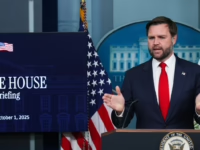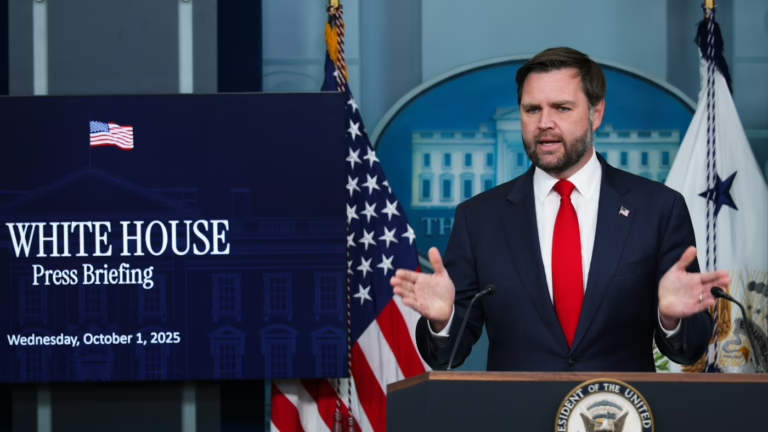Vice President JD Vance addresses the White House press briefing on the day the government shutdown began. Vance is among Republicans emphasizing that there is sufficient time to extend ACA premium tax credits.
Alex Wong/Getty Images
hide caption
toggle caption
Alex Wong/Getty Images
Currently, a heated debate unfolds on Capitol Hill regarding the urgency and timing for lawmakers to renew subsidies for the Affordable Care Act (ACA) marketplaces. These marketplaces serve approximately 24 million Americans who lack employer-sponsored insurance or coverage through public programs like Medicaid.
This dispute is central to the government shutdown that commenced on October 1.
Democrats stress the immediate need to extend the enhanced premium tax credits, especially with open enrollment just weeks away. Conversely, Republicans argue that since these subsidies expire in December, there is ample time to deliberate and finalize policy decisions later.
So, which perspective holds more weight?
Jon Godfread, North Dakota’s insurance commissioner, warns that the opportunity to act is closing fast. He insists that the enhanced subsidies must be renewed before the November 1 start of open enrollment. “We need to address this now,” he urges.
Missing this critical deadline, Godfread explains, would make it extremely difficult to encourage consumers to return to the marketplace after being priced out. “I doubt many will come back once they’ve been forced away,” he adds.
Insurance Leaders Across Political Lines Demand Swift Resolution
Godfread emphasizes that this issue transcends partisan divides. As a Republican and president of the National Association of Insurance Commissioners-a body representing state insurance regulators nationwide-he notes unanimous support for extending these tax credits regardless of political affiliation. “Whether red or blue states, appointed or elected officials, the consensus is clear,” he states.
For months, insurance regulators have alerted Congress about the looming crisis. “Since January, we’ve sent four separate letters,” Godfread reveals. He also spent May in Washington, D.C., meeting with legislators to highlight the severe impact that letting the enhanced premium tax credits lapse would have on consumers-a “double blow,” as he describes it.
Premiums Could Surge from Hundreds to Thousands Monthly
“Healthcare costs are rising, which already pushes premiums higher,” Godfread explains. “Removing these subsidies would be like pulling the rug out from under families.” He illustrates this with an example: a family paying $800 monthly for insurance could see that amount skyrocket to $3,000.
According to a recent analysis by the Kaiser Family Foundation (KFF), premiums could increase by an average of 114% if subsidies expire.
In North Dakota, the hardest hit will be farmers and ranchers, Godfread notes. “The enhanced subsidies have encouraged more agricultural families to secure coverage, which has been a positive development,” he says.
KFF data shows that over 75% of ACA enrollees reside in states won by President Trump in 2024. Additionally, a KFF poll released last Friday found that 78% of voters across party lines support continuing the enhanced subsidies, including a majority of Republicans and MAGA supporters.
Urgency for Legislative Action
After a challenging initial decade, ACA marketplaces like Healthcare.gov are now functioning effectively, Godfread observes. Consumers generally find plans affordable and satisfactory. However, if premiums spike and healthier individuals drop coverage, the risk pool deteriorates, leading to higher costs and more uninsured individuals. This, in turn, increases uncompensated care burdens on hospitals and strains state budgets.
Godfread acknowledges that some lawmakers hesitate due to concerns about subsidy costs and rising premiums. “Those are separate issues,” he argues. “We can address healthcare and pharmaceutical expenses, but first, we must ensure consumers have access-and these subsidies are key to that.”
He remains cautiously optimistic that growing awareness will prompt legislative action. “The conversations are happening, but now we need decisive steps,” he insists.
States Prepared to Implement Changes
With open enrollment looming-November 1 nationwide except for Idaho, which starts October 15-insurers have finalized their 2026 rates. Yet, Godfread explains that if Congress acts swiftly, consumers can still benefit from subsidized premiums.
“Nearly all states required insurers to submit two sets of rates-one assuming subsidies continue, and one without,” he says. “If subsidies are extended cleanly, most states are ready to implement those rates immediately.”
The crucial factor remains acting before open enrollment begins so consumers encounter affordable options when shopping for plans. “I don’t expect people to give the marketplace multiple chances,” Godfread concludes.
























